Siamese
Felis catus
Originated from temple cats in Thailand!
Advertisement
Siamese Scientific Classification
- Kingdom
- Animalia
- Phylum
- Chordata
- Class
- Mammalia
- Order
- Carnivora
- Family
- Felidae
- Genus
- Felis
- Scientific Name
- Felis catus
Read our Complete Guide to Classification of Animals.
Siamese Conservation Status
Siamese Facts
- Fun Fact
- Originated from temple cats in Thailand!
- Other Name(s)
- Meezer
- Temperament
- Intelligent, calm and sociable
- Diet
- Omnivore
View all of the Siamese images!
Did you know that Siamese kittens are born with no point markings? Siamese cats have a special enzyme in their bodies that is temperature-sensitive, and it allows the pigment of their fur to collect in cooler parts of their bodies, such as their ears, paws, tails, and faces.
Siamese cats are a smart, loyal, sweet-tempered, and chatty cat breed that loves nothing more than to play and snuggle with their humans.
See all of our expert product reviews.
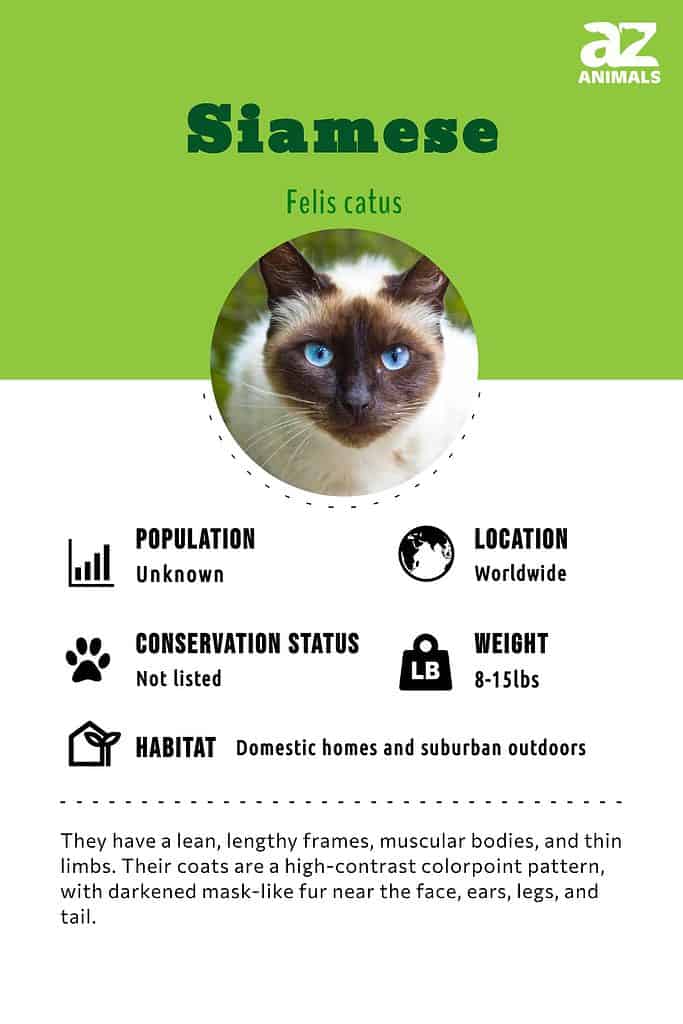
Traits: What to Know Before You Buy
- Siamese cats are loving and loyal companions, but you must be prepared to give them a lot of love and companionship in return. They don’t like to be left alone for long periods of time, and they don’t respond well to being ignored.
- Purebred Siamese is considered hypoallergenic.
- Because the breed was originally cross-eyed, Siamese cats are more prone to vision problems as they age.
- They thrive in stable, consistent environments and love routine.
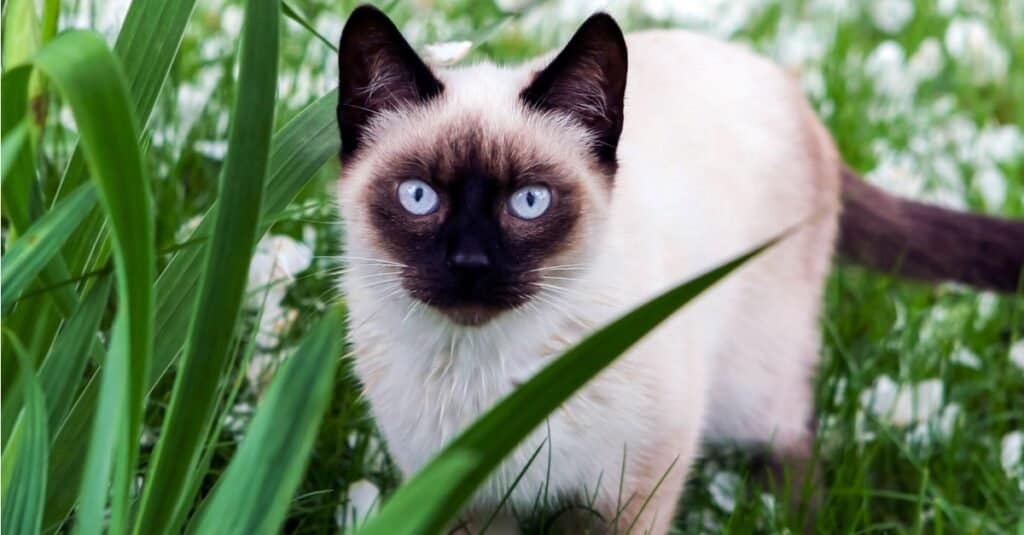
Siamese cats are hypo-allergenic.
©iStock.com/Vital Hil
Breed History
The first historical mention of the Siamese cat as in an ancient manuscript titled the Tamra Maew (The Cat-Book Poems) which originated in the Ayutthaya Kingdom, a kingdom in Siam that lasted from 1351-1767 AD). A poem described cats from Thailand as being rare like gold, and promises that any owner of one will become rich.
It’s obvious that one early King of Siam valued these cats highly (so legend says), as he used them as guard cats in his temple. They were trained to perch on tall columns and pounce on anyone that might threaten the king. Western culture first noted the Siamese cat in the form of Peter Simon Pallas, a German explorer and naturalist, how described the Siamese cat in his writings.
In the late 1800’s, the King of Siam gifted Owen Gould, the English consulate general in Bangkok, with a pair of breeding Siamese cats–the first to enter Europe. He named them Pho and Mia, and were exhibited by his sister at the Crystal Palace in 1885. Ironically, the first Siamese cats to come to the United States were also gifts from the King of Siam to a friend. While these cats remained mysterious and rare into the early 20th century, there was a boom imports and registrations of these cats after World War II.
Health and Entertainment for your Siamese
See all of our expert product reviews.

The first Siamese cats came to Europe as a gift from the King of Siam to the British consulate general in Bangkok.
©BeansproutP/Shutterstock.com
Personality
Siamese cats have a reputation for being high-strung and aggressive, but this is not the case for any well-bred and well-loved Siamese cat. They make excellent companions and family pets.
In general, Siamese cats are:
- Extremely intelligent
- Affectionate
- Playful
- Incredibly vocal
They prefer to have plenty of affection and attention from their human family, and their intelligence and curiosity make every moment interesting. They learn quickly, and because they are an active breed, you can teach them to play games like fetch very easily. They also love to “chat” with their humans all day long, even if their humans don’t always talk back.
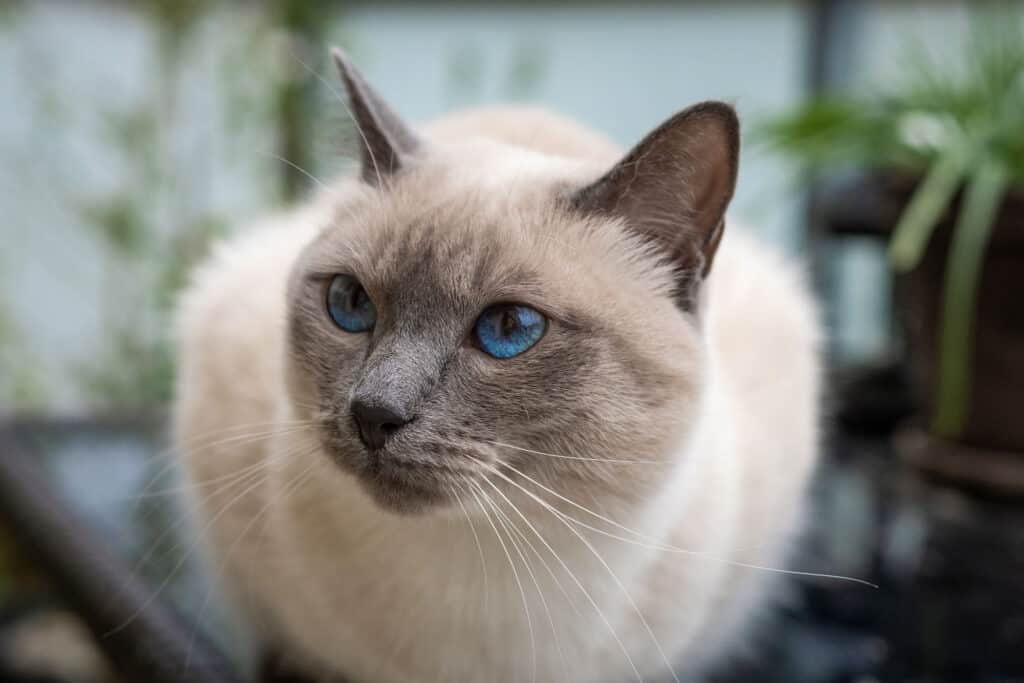
Siamese cats make excellent pets, being extremely intelligent, affectionate, playful, and highly vocal.
©Lucie K/Shutterstock.com
Size and Weight
Siamese is not a large breed. They may grow up to 14 inches in length and typically weigh less than 10 pounds. On the upper end of the size range, males can weigh up to 14 pounds.
A Siamese cat named Katy once made the news for being the world’s fattest cat. In 2003, she weighed 50 pounds, which is as much as a small child.

Siamese cats can grow up to 14 inches in length and typically weigh less than 10 pounds.
©Chomipoo/Shutterstock.com
Price
These cats are a highly sought-after breed, so purebred cats can come with a hefty price tag. However, when you purchase a Siamese cat from a reputable breeder, you’re also paying for a cat or kitten that has been given a thorough wellness check, plenty of socialization, and all of its necessary shots. Many breeders also give clients a wellness guarantee, and some include the cost of pet insurance in the adoption fees.
The price will depend on several factors, such as:
- Pedigree
- Coloring
- Age
- Demand
- Geographic location
If you are hoping to buy a show-quality cat, you can expect to pay up to $3,000. However, if you’re simply buying a purebred companion, most Siamese cats and kittens will cost between $250-1,200. You may also be able to find a Siamese cat at a nearby rescue shelter for considerably less, but it might require more patience. You can also check to see if there is a Siamese-specific rescue shelter in your area.
Some of the rare colorations, such as lilac point and flame point, may cost up to $2,000 depending on the breeder and geographic location.
When you’re considering the cost of getting a Siamese cat, it’s important to take other factors into account as well. Siamese is a naturally lean and active breed, so they need to have a quality, high-protein diet. Owners should expect to spend at least $300 on high-quality wet and dry food per year.
While Siamese is a generally healthy breed, it’s important to schedule regular vet visits, especially when they are kittens. Pet insurance may help to lessen these costs, but it’s best to budget a few hundred dollars for routine and unplanned vet visits each year.

A show-quality Siamese cat can cost upwards of $3000, while a pet purebred can range from $250-1,200.
©Linalyan/Shutterstock.com
Kittens
Kittens are even more playful and energetic than their adult counterparts. They do best with plenty of affection and socialization when they’re young. This is key to helping them develop into friendly, well-rounded adults.
One interesting fact about these kittens is that they are born with a purely white or cream coat. They have a special “temperature control” enzyme that allows them to develop the black, brown, blue, and gray point colors that they are known for on the cooler parts of their bodies.
Most cat breeds hit puberty around six months of age, but these kittens may reach sexual maturity as early as four months. If you’re adopting a Siamese as a companion, it’s important to have your furry friend spayed or neutered as soon as possible.
In general, the kittens are good with children, as long as the children understand how to interact with a cat. It’s important to monitor all interactions with young children so that they’re a positive experience for both the child and the cat. Because these cats bond so well with humans, raising a kitten alongside your child ensures that the two will be inseparable friends for life.

Siamese kittens can reach sexual maturity as early as 4 months of age.
©Mariya Zimarina/Shutterstock.com
Lifespan
The average lifespan of a healthy Siamese cat ranges from 12 to 20 years. However, the oldest Siamese on record was a 30-year-old cat named Scooter who obtained the Guinness World Record for the world’s oldest living cat in 2016.
The most common ailments that can shorten these cats’ lifespan are hereditary conditions like congenital heart disease and asthma. In addition, because of their original genetic predisposition for crossed eyes, these cats typically have worse vision than most breeds and are susceptible to vision loss and blindness as they age.
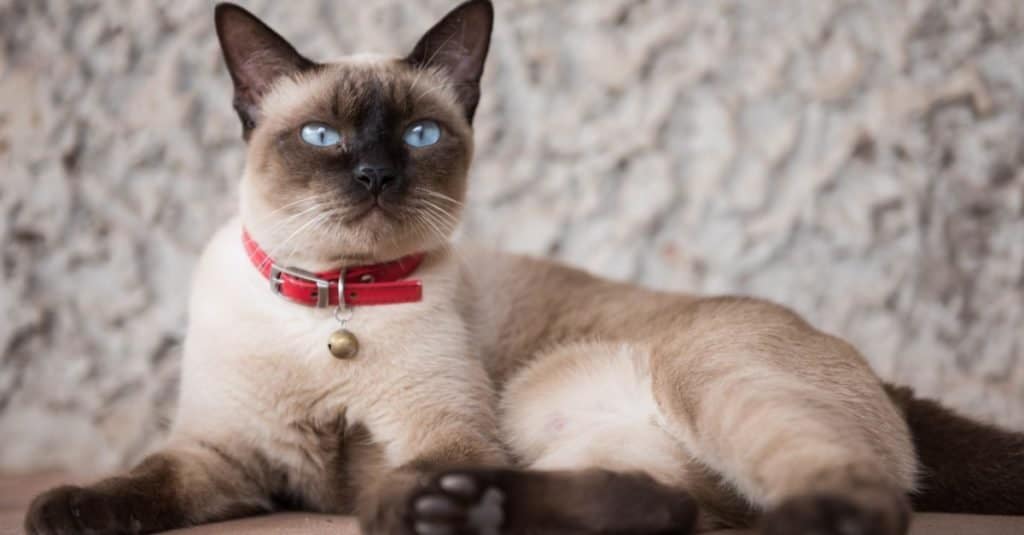
The average lifespan of a Siamese cat is 15-20 years.
©Suwanon Wongsaphan/Shutterstock.com
Breed vs. Mixed
Purebred Siamese cats have several notable traits, including the following:
- Dark points in their coat
- A sleek, muscular physique
- Blue, almond-shaped eyes
- Long, tapered, wedge-shaped head
- A short, glossy coat that is white, cream, or fawn-colored
If your cat has Siamese traits but also tabby stripes, a fluffy coat, a round head, black fur patches, or eyes that aren’t blue, you likely have a Siamese mix. As long as you aren’t in the market for a show-quality Siamese, a Siamese mix is just as wonderful of a companion as a purebred Siamese. They are also much easier to find at a rescue shelter.
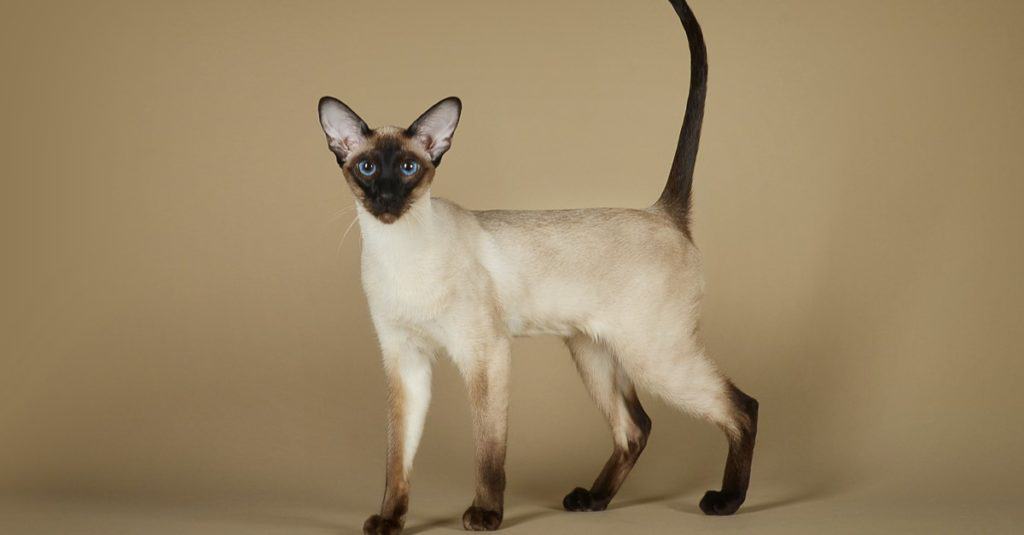
The Siamese cat is characterized by a sleek, muscular body, blue eyes, a short, glossy coat colored white, cream, or fawn, and dark points.
©vivver/Shutterstock.com
Types of Siamese Cats and Colors
According to the breed standard, there are only four recognized colors:
- Chocolate point
- Seal point
- Lilac point
- Blue point
However, there are many other coat types with names such as tortie point, flame point, cinnamon point, fawn point, and lynx point. All color types of these cats have white or cream bodies, but they often darken with age.
View all 293 animals that start with SSiamese FAQs (Frequently Asked Questions)
Are Siamese herbivores, carnivores, or omnivores?
Siamese are Omnivores, meaning they eat both plants and other animals.
What Kingdom do Siamese belong to?
Siamese belong to the Kingdom Animalia.
What class do Siamese belong to?
Siamese belong to the class Mammalia.
What phylum to Siamese belong to?
Siamese belong to the phylum Chordata.
What family do Siamese belong to?
Siamese belong to the family Felidae.
What order do Siamese belong to?
Siamese belong to the order Carnivora.
What genus do Siamese belong to?
Siamese belong to the genus Felis.
What type of covering do Siamese have?
Siamese is covered in hair.
How many babies do Siamese have?
The average number of babies a Siamese has is 4.
What is an interesting fact about Siamese?
Siamese originated from temple cats in Thailand!
What is the scientific name for the Siamese?
The scientific name for the Siamese is Felis catus.
What is the personality of a Siamese cat?
Siamese cats are an intelligent and extremely vocal breed. They have an energetic and lively personality, so it’s important that they get enough exercise and mental stimulation. They can also be more demanding than other breeds, so they sometimes get a reputation for being high-maintenance.
Are Siamese cats friendly?
Siamese cats are friendly and energetic, and they can get along well with other cats, dogs, and children.
Are Siamese cats aggressive?
Siamese cats are not inherently aggressive, but they are known to become aggressive if their needs aren’t met. A hungry, bored, neglected, or anxious Siamese is more likely to display aggression, especially towards other cats.
What is special about Siamese cats?
Siamese cats will form strong bonds with their owners, and they love getting lots of affection and playtime. While there are no purely hypoallergenic cats, Siamese is considered hypoallergenic because they do not shed as much as other cats, and they produce less of the protein that many people are allergic to.
Many Siamese cats also have genetic visual deficiencies that can reduce their eyesight and limit their depth perception. This can make them more sensitive and emotional than other breeds, but they are also wonderful with families when given a safe, loving environment.
How long do Siamese cats live?
Siamese cats are a relatively healthy breed, so they can live 12-20 years.
What is the difference between a Ragdoll and a Siamese cat?
The main difference between the two is that Ragdolls are more independent than Siamese, who require a lot of cuddling and attention. Siamese is prone to being gloomy and depressed if not given enough love. On the other hand, Ragdolls strike the perfect balance between cuddling and asserting independence.
What are the differences between a Birman and a Siamese?
The main differences between a Birman cat and a Siamese cat are their coats, breed origins, and rarity (price).
Thank you for reading! Have some feedback for us? Contact the AZ Animals editorial team.
Sources
- FAQ Cats, Available here: https://faqcats.com/how-much-is-a-siamese-cat-worth/
- BBC, Available here: http://news.bbc.co.uk/2/hi/europe/2787627.stm
- The Cat Fancier's Association, Available here: https://cfa.org/siamese/siamese-breed-standard/
- Petfinder, Available here: https://www.petfinder.com/cat-breeds/siamese/

















